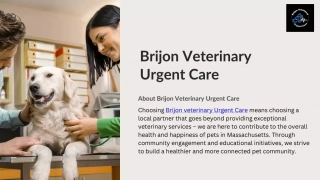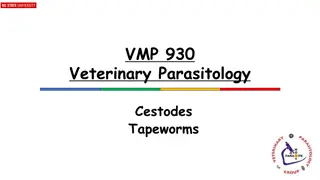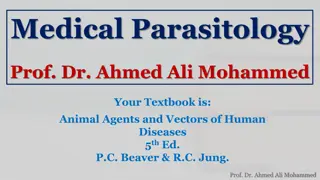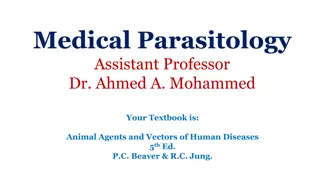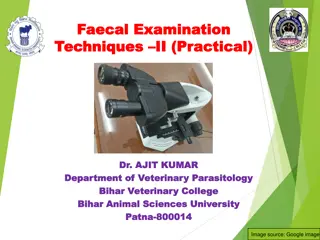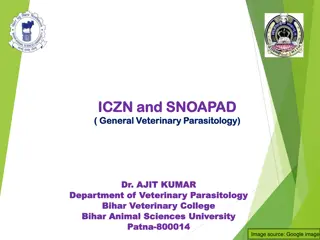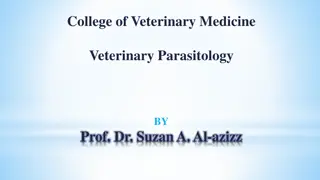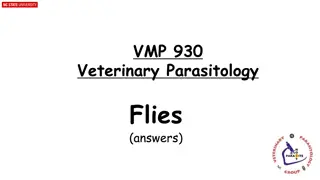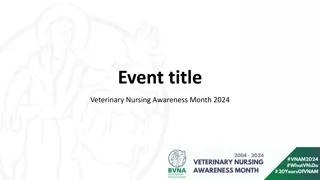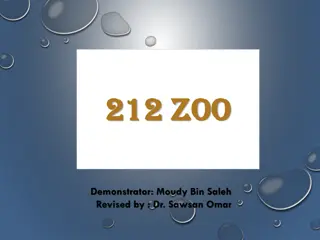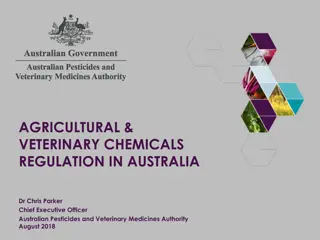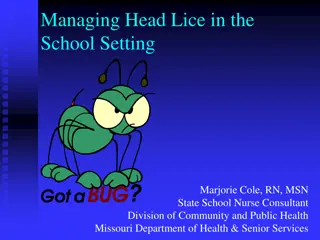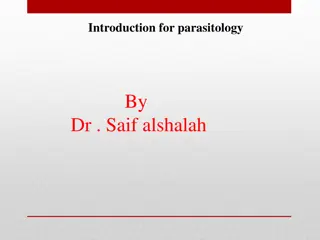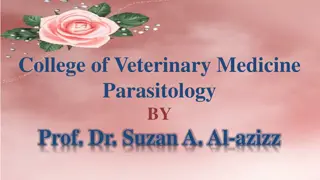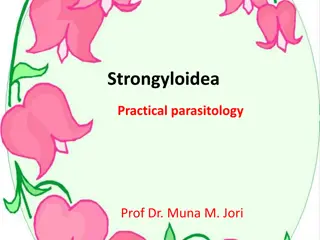Veterinary Parasitology: Flea & Lice Overview
Explore the world of veterinary parasitology with a focus on fleas and lice. Dive into topics such as the life cycle of fleas, their preferred habitat, pathology concerns, and Flea Allergy Dermatitis. Learn about identifying stages in the flea life cycle, common flea species, and how to manage Flea Allergy Dermatitis in pets.
Download Presentation

Please find below an Image/Link to download the presentation.
The content on the website is provided AS IS for your information and personal use only. It may not be sold, licensed, or shared on other websites without obtaining consent from the author. Download presentation by click this link. If you encounter any issues during the download, it is possible that the publisher has removed the file from their server.
E N D
Presentation Transcript
VMP 930 Veterinary Parasitology Flea & Lice (questions)
Flea - Life Cycle True or False Fleas have a Simple metamorphosis (= Hemimetabolous). This means that all the life stages (Larva (x3), Pupa, Adult) are similar in appearance. The larvae of fleas feed on debris in the environment. Fleas show high host specificity
Flea - Life Cycle List 1. List the life stages of Fleas that are NOT parasitic. Multiple Choice ___ 2. Which stage(s) of the flea life cycle can often be found in the environment ? A. All the following B. Egg C. Larvae D. Pupae E. Adult
Fleas of Veterinary Importance Fill in the Blank. The most prevalent flea species on dogs and cats in NC are _________________ Pest and Diseases Image Library , Bugwood.org
Flea Preferred Habitat Matching Which habitat characteristic leads to Survival v/s Mortality ? ____ 1. Temperature A. Survival B. Mortality ____ 2. Arizona ____ 3. Humidity
Fleas - Pathology Multiple Choice ___ 1. Which of the following is not a pathology concern for flea infestations? A. Pruritus B. Dipylidium caninum C. Toxoplasma gondii D. Flea Allergy Dermatitis E. Pruritus + excoriations + pyoderma F. Blood Loss
Flea Allergy Dermatitis Fill in the Blank What is the primary target for a veterinarian, who is presented with a pet suffering with Flea Allergy Dermatitis ? ________________________________________________ What should the owner do to help prevent future incidence of Flea Allergy Dermatitis ? ____________________________________________
Flea Allergy Dermatitis Matching Regarding Flea Allergy Dermatitis; match the pet with its most common FAD presentation. A. Cat B. Dog ____ 1. The Flea Triangle (w/ corners at Mid-back, tail head, back leg) ____ 2. Miliary Dermatitis on face, neck, and back
Flea Allergy Dermatitis Matching Match the pathogen with the primary presentation of canine dermatitis. (Fleas, Sarcoptes, Demodex)
Flea Control Fill in the Blank To decrease most of the total flea population one should target the ___________________ Integrated Flea control includes: ___________________________________________________ Flea products (insecticides) that are toxic to cats contain _________________________
Lice Biology Matching Compare and contrast the life cycles of fleas and lice. ____ 1. Simple Metamorphosis A. Fleas B. Lice C. Both ____ 2. Low Host Specificity ____ 3. All Life Stages on Host ____ 4. Environmental Control Required ____ 5. Insects
Lice - Treatment Fill in the Blank 1. The lice ___________ are cemented to the hair or feathers of their host. 2. When treating a lice infestation, a repeat treatment is required because ________________________________. 3. When treating a lice infestation, it is not necessary to treat the environment because _____________________________. 4. Why don t systemic insecticides work against poultry lice ? _____________________________.
Lice Life Cycle List 1. List one way, in which lice are transmitted.
Lice Ecology Multiple Choice ___ 1. In which season do lice populations and transmission tend to be highest ? A. Winter B. Summer ___ 2. Which of the following does not promote an increase in lice populations and transmission ? A. Cold weather stress B. Thicker hair coats C. Increased Pasture Height D. Increased huddling behavior E. Kept in barns
Lice Groups Matching Compare and contrast the two groups of lice. ____ 1. Narrow head ____ 2. Mammal hosts ____ 4. Anemia ____ 5. Bird hosts ____ 6. Feeds on fur, hair, feathers, epidermal debris. ____ 7. Decreased productivity ____ 8. Systemic Insecticides A. Mallophagan (chewing) B. Anopluran (sucking) C. Both
Lice - Genera Matching In which group of lice does each taxonomic genus belong? ____ 1. Trichodectes ____ 2. Notoedres ____ 3. Felicola ____ 4. Haematopinus ____ 5. Bovicola (Damalinia) ____ 6. Linognathus ____ 7. Menacanthus A. Mallophagan (chewing) B. Anopluran (sucking) C. Neither


